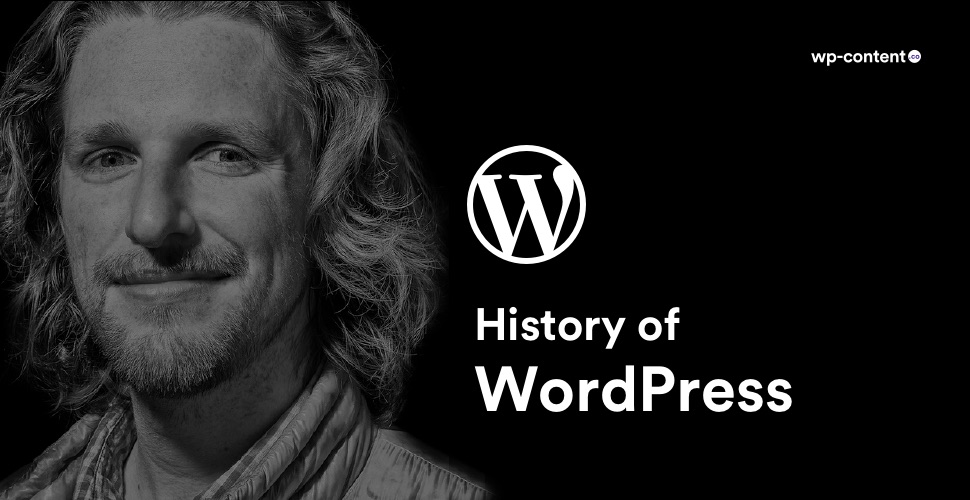History of WordPress is fascinating – the journey of a teenager to make the web a better place and become a commercial Robin Hood. So grab your popcorn and relax because it is a long story spanning decades. So here we go!
- 2002: b2/cafelog
- 2003: Birth of WordPress
- 2004: Plugins
- 2005: Themes and Automattic
- 2006: WordCamps
- 2007: Gravatar
- 2008: WordPress Theme Directory
- 2009: WordCamp India
- 2010: Twenty Ten theme
- 2011: Admin Bar
- 2012: Media Manager
- 2013: Automatic updates
- 2014: Scroll Kit and Longreads
- 2015: WooCommerce
- 2016: Email login
- 2017: More widgets
- 2018: Gutenberg
- 2019: Site Health Feature
- 2020: Auto-updates for themes, plugins and major releases
- 2021: Drag-and-drop for blocks and patterns
- 2022: Full Site Editing and More
2002: b2/cafelog
WordPress owes its birth and growth to necessity and luck. It all began in 2002 when the then famous blogging tool b2/cafelog, developed by French programmer Michel Valdrighi, discontinued its updates leaving thousands of its users including an 18-year-old Matt Mullenweg without any developer support. Matt Mullenweg then joined hands with another b2 user Mike Little to create a fork of b2 and called it WordPress as suggested by Christine Tremoulet, a friend of Mike Little.
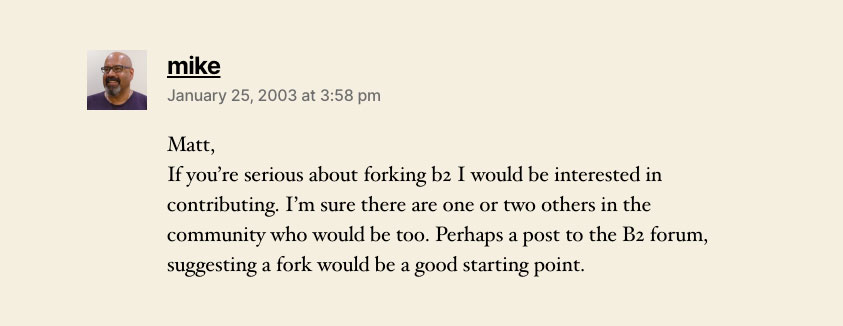
2003: Birth of WordPress
On May 27, 2003, Matt announced the availability of the first version of WordPress, WordPress 0.7. A texturize engine, links manager, XHTML 1.1 compliant templates, and a new administration interface were some of the features of this version. By the end of 2003, Matt renamed “b2” files to “wp” (dubbed as The Great Renaming) and consolidated most of the files into the wp-admin and wp-includes folders.

2004: Plugins
The year 2004 was a milestone for WordPress. In January 2004, WordPress 1.0 (code named “Davis” after the Jazz great Miles Davis) was released. This version set the tradition of naming the WordPress versions after Jazz legends. Besides naming the versions, Matt also includes a plugin called Hello Dolly in every release as a tribute to Louis Armstrong.
“This is not just a plugin, it symbolizes the hope and enthusiasm of an entire generation summed up in two words sung most famously by Louis Armstrong: Hello, Dolly.”

Version 1.2 of WordPress code-named Mingus (after Charles Mingus) was released in May. It included support for a new feature named “Plugins” and ushered in a new era of WordPress. The plugin system was the brainchild of Ryan Boren. The developers could manipulate the functionality of WordPress by writing their own plugins and also share it with others. The non-technical people could easily install the plugins with specific functionality instead of coding.
In 2004, luck favored WordPress when Movable Type, their competitor decided to change their pricing policy. The hike resulted in WordPress gaining chunks of Movable Type’s clients who were dissatisfied with the policy changes. Mingus was a hit with them.
2005: Themes and Automattic
If 2004 was for plugins, 2005 was for Themes. The Version 1.5 named Strayhorn in honor of Billy Strayhorn was released in February 2005. It introduced the theme system, Dashboard and static pages. Kubrick (actually called Default and created by Michael Heilemann) became the first official default theme for WordPress. In the words of Matt,
“1.5 has been our most user-focused development ever: we’ve listened closely to your requests, complaints, praise, pleas, and we’ve done our best to address these both in the core and through enabling plugin authors more flexibility….In 1.5 we have created an incredibly flexible theme system that adapts to you rather than expecting you adapt to it. You can have your entire weblog run through a single file, just like before, or you can literally have a different template for every single different category. It’s as much or as little as you want.”
WordPress 2.0 or Duke (after Duke Ellington) was also released in the same year with a new user role, persistent caching functionality and backend UI. It also had the much-loved spam filtering plugin Akismet pre-installed.

The year also saw the birth of Automattic in the able hands of Matt Mullenweg.
2006: WordCamps
This year did not see much action in the development front of WordPress. Automattic concentrated on cementing their base and brand image in this year. The former Oddpost CEO and the Yahoo! Executive Toni Schneider was hired as Automattic CEO. In March, Automattic filed the trademark registration for WordPress and WordPress logo.
Matt came up with the idea to organize a “Camp” where WordPress lovers could get together and exchange ideas. He shared his thoughts on his blog Ma.tt in July. On August 06, the first-ever WordCamp was organized in San Francisco and Matt delivered his first “State of the Word”. As of now, WordCamps have been held in all continents except Antarctica and holding the WordCamp in San Francisco with the “State of the Word” from Matt has become a tradition. We will share our experiences with sponsoring and attending WordCamps in detail in later articles.
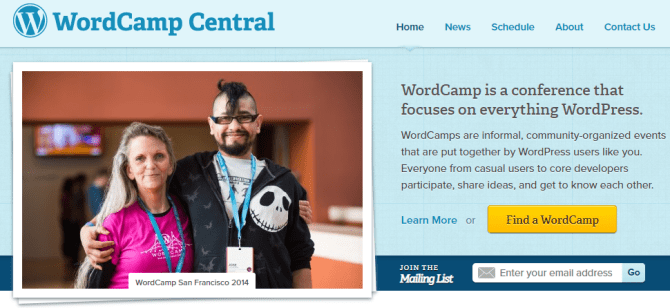
2007: Gravatar
The year saw 3 WordPress releases, acquisition of Gravatar by Automattic, Beijing hosting the first-ever WordCamp outside of San Francisco and WordPress’s first major security breach.

Version 2.1 or “Ella” (in honour of Ella Fitzgerald, the jazz singer) had a new UI, autosave, spell check, search engine privacy option, new hooks and APIs as the main features.
Version 2.2 or “Getz” (as a tribute to the jazz saxophonist Stan “The Sound” Getz) gave some much-needed new features to the WordPress community like Widgets, full atom support, blogger importer, infinite comment stream and speed optimizations.
Version 2.3 or “Dexter” (honouring the jazz legend Dexter Gordon) was the last release in 2007. It had native tagging support allowing usage of tags in addition to categories on posts. Other features included update notifications, canonical URLs, and a new post status – “pending review.”
The growing popularity of WordPress attracted the attention of hackers and they attacked many SEO blogs. At one point WordPress’s own servers were found to be vulnerable. The issues were solved but not before raising the question of WordPress’s security in everyone’s minds. Even in 2020, you can find bloggers publishing articles on the security of WordPress.
2008: WordPress Theme Directory
WordPress had three releases in 2008. The year saw the introduction of the WordPress Theme Directory and the Dashboard as we know it today. WordPress also bagged the Infoworld’s “Best of open source software awards: Collaboration”
Version 2.5 or “Brecker” (after Michael Brecker, the Jazz saxophonist and composer) had improved UI, widgets and the shortcode API.
Version 2.6 or “Tyner” (honouring McCoy Tyner, the jazz pianist) was the result of a usability study done on the 2.5 version. It introduced post revisions and Press This. The features that we take for granted like Word count, Image captions, Bulk management of plugins, Plugin update notification bubble and Theme Previews made their first appearance in this version. These features served to add more power to WordPress as a CMS.
The last release of 2008, Version 2.7 or “Coltrane” was named after the legendary bebop and hard bop jazz saxophonist and composer John Coltrane. It was the last time WordPress had to be manually upgraded. Coltrane changed the look and usability of WordPress. A new interface, dashboard, customizable screens were the highlights of this release.
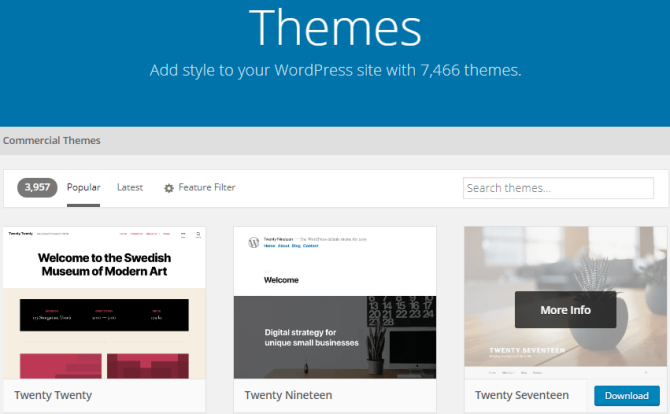
2009: WordCamp India
WordPress released two new versions and also bagged the Open Source CMS Award for Overall Best Open Source CMS. India entered the WordCamp map with hosting the first “WordCamp India” gathering at Delhi and attended by none other than Matt Mullenweg.
Version 2.8 or “Baker” was named after the American jazz trumpeter and vocalist Chesney Henry Baker Jr. Themes, widgets, taxonomies and overall speed were overhauled. Features like automatic installation of themes and the addition of the CodePress editor gained the hearts of WordPress lovers.
Version 2.9 or “Carmen” (after the jazz vocalist Carmen McRae) saw some new features like Global undo/”trash” feature to retrieve posts or comments from Trash, built-in image editor, batch plugin update and compatibility checking for up to 10 plugins and easier video embeds. Canonical support improved the SEO experience.
2010: Twenty Ten theme
June 2010 saw Automattic transferring the ownership of the WordPress trademark and logo to the WordPress Foundation. This move ensured the continued existence of WordPress as an open-source platform.
The point of the foundation is to ensure free access, in perpetuity, to the software projects we support. People and businesses may come and go, so it is important to ensure that the source code for these projects will survive beyond the current contributor base, that we may create a stable platform for web publishing for generations to come. As part of this mission, the Foundation will be responsible for protecting the WordPress, WordCamp, and related trademarks.
WordPress 3.0 or “Thelonious” was released as a tribute to American jazz pianist and composer Thelonious Sphere Monk. This release was groundbreaking due to the presence of a new feature for custom post types. This customization feature helped WordPress to overcome the simple blogging tool tag and set it on the path to becoming the CMS king as we know it today.
Thelonious had a new default theme called Twenty Ten thus starting the tradition of a new default theme for each year. It had also merged former WordPress MU with WordPress Core and renamed it to Multisite and increased bulk plugin updates limits to 15. Custom menu management and API’s for custom headers and custom backgrounds were some of the other highlights.
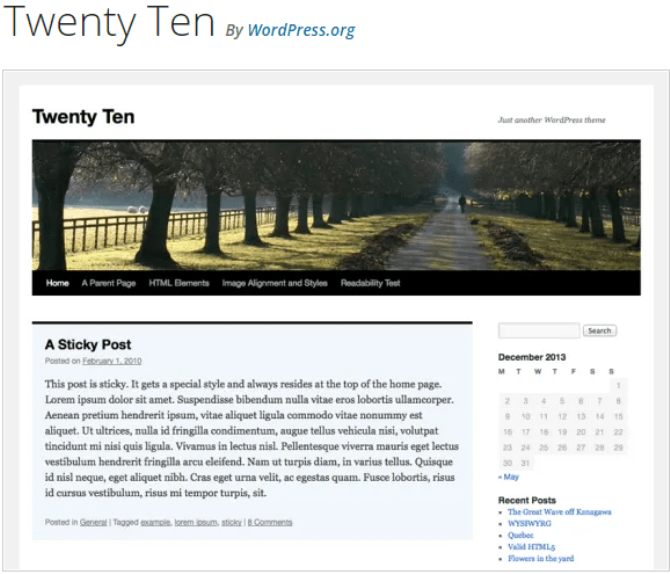
WordPress also won digitalsynergy’s “Hall of Fame CMS category in the 2010 Open Source”.
2011: Admin Bar
It was a busy year for WordPress with 3 releases and winning Infoworld’s “Bossie award for Best Open Source Software.” 2011 also saw the arrival of some plugins with e-Commerce functionalities enabling people to create online stores and make money out of WordPress.
Version 3.1 named “Reinhardt” in honour of the jazz guitarist Django Reinhardt was the first release of 2011 introducing Post Formats and the Admin Bar. The Admin Bar assured access to the backend of all pages while logged-in to your site. Other features included a redesigned linking workflow, streamlined writing interface and blue admin scheme.
Version 3.2 or “Gershwin” (after the noted composer and pianist George Gershwin) shows the growth of the WordPress community as it was released on American Independence Day, just four months after Reinhardt. This release saw WordPress becoming faster and lighter with a revamped Dashboard, Admin bar and Distraction Free Writing mode. “Twenty Eleven” was the default theme.
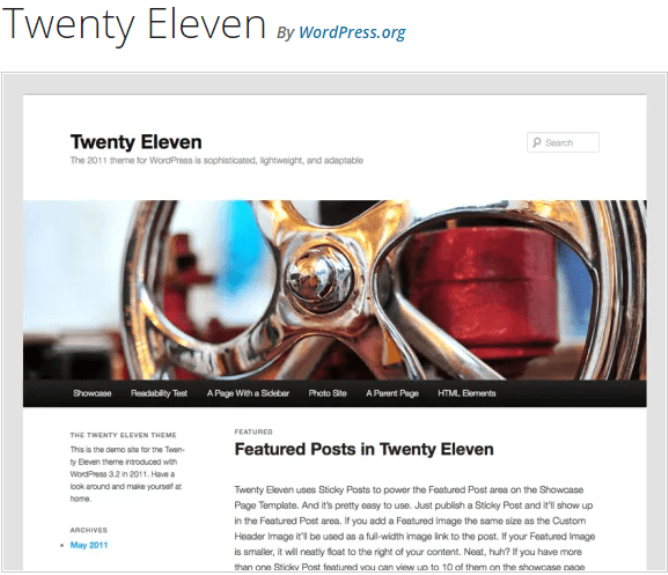
Version 3.3 or “Sonny” dedicated to jazz saxophonist Sonny Stitt concentrated on providing a friendly experience for beginners with welcome messages and feature pointers. A new drag and drop uploader, navigation and toolbar enhancements and improved support for iPad and other tablets were also included.
2012: Media Manager
WordPress came out with just two releases focusing on improving the user experience.
Version 3.4 or “Green” after the guitarist Grant Green included improvements to theme customization, custom headers, Twitter embeds, and image captions. The theme customizer and theme previewer functions enabled new users to create image galleries and preview it before deciding on a new theme.
Version 3.5 or “Elvin” in honour of drummer Elvin Jones had Twenty Twelve as the default theme. It also introduced the new media manager.
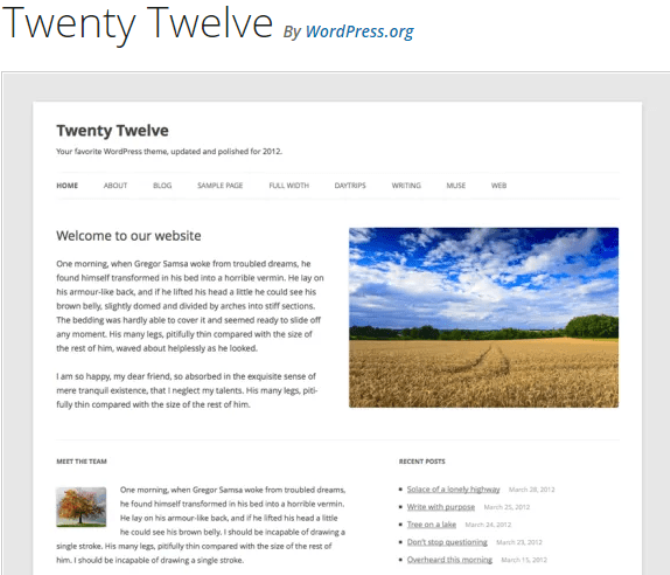
2013: Automatic updates
In January 2013, Simperium, known for its data synching projects, became part of Automattic. There were three updates that year – in August, October and December – bearing testimony to the passion of the WordPress community.
Version 3.6 dubbed “Oscar” after the great jazz pianist Oscar Peterson. It had a new default theme called “Twenty Thirteen,” dynamic and scalable Revisions, built-in Audio and Video support, improved Autosave and Post Locking.
Version 3.7 or “Basie” (to honour jazz pianist Count Basie) was the result of the new plugin-first development process. It came with the new automatic updates feature that allowed WordPress to automatically update your site’s software for minor releases. It also had stronger password suggestions and better global support.
Mat called the WordPress Version 3.8 (named “Parker” after Charlie Parker, the Jazz saxophonist and composer) “ the most beautiful update yet.” It had a new magazine-style default theme called “Twenty Fourteen.” It boasted of an uncluttered aesthetic Dashboard and responsive admin interface enabling WordPress to work in mobiles and tablets too.

2014: Scroll Kit and Longreads
For the first year in WordPress history, non-English downloads for WordPress surpassed the English downloads. Scroll Kit and Longreads became part of the Automattic family. The Scroll Kit was soon closed down but Longreads still exists. On the development front, there were three releases.
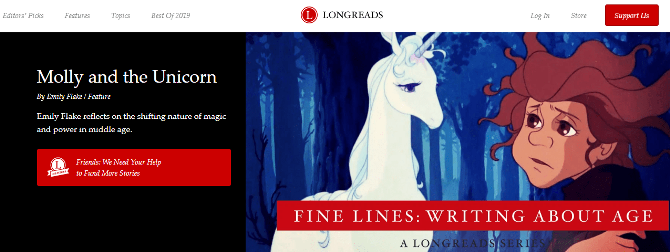
Version 3.9 or “Smith” (in honour of jazz organist Jimmy Smith). It provides a smooth media editing experience with improved Visual Editor, live widget previews, audio playlists and Image and media improvements like uploading images via drag and drop from desktop and image editing enhancements.
WordPress 4.0 “Benny” (the jazz clarinettist and bandleader Benny Goodman) update focussed on providing a smoother writing and management experience. An improved media library with grid view, a post editor showing previews of embedded content and a new plugin install screen to make plugin search easy and quick were instant hits.
WordPress 4.1 “Dinah” (the jazz singer and pianist Dinah Washington) had “Twenty Fifteen” – a customizable blogging theme designed with a mobile-first approach – as the default theme. Backed by Google’s Noto font family, Twenty Fifteen ensured flawless language support for WordPress. This version also introduced a revamped Distraction Free Writing mode.
2015: WooCommerce
WordPress bagged the CMS Critic Award’s “Best CMS for Personal Websites”. Automattic acquired WooCommerce, the eCommerce plugin.

Version 4.2 or “Powell” (after the jazz pianist Bud Powell) made content sharing easier with the Press This feature. This update had new characters and emoji support, faster Plugin updates, more Auto Embeds (Tumblr, Kickstarter) and theme switching in Customizer.
Version 4.3 or “Billie” (after the Jazz singer Billie Holiday) introduced formatting shortcuts in the visual editor, Menus in Customizer, built-in site icons support and Stronger Passwords by Default.
Version 4.4 “Clifford” (jazz trumpeter Clifford Brown) introduced the default theme “Twenty Sixteen” – a modern representation of the classic blog design. Other features include responsive images, embeddable posts, REST API integration, comment query improvements and two new Objects (Term and Network).
2016: Email login
Version 4.5 “Coleman” (jazz saxophonist Coleman Hawkins) allowed users to sign in with their Email IDs for the first time. It also had added inline links, more formatting shortcuts, responsive previews in Customizer, theme logo support, visual editor enhancements and smart image resizing.
Version 4.6 “Pepper” (in honour of jazz baritone saxophonist and composer Park Frederick “Pepper” Adams III) did not have any drastic changes. It caused an increase in speed by introducing Naive fonts for Dashboard. Other featured changes were Streamlined Updates for WordPress Themes and Plugins and Editor Improvements including Inline Link Checker, Auto-save and recovery.
Version 4.7 “Vaughan” (jazz vocalist Sarah “Sassy” Vaughan) was the last release of 2016. This version supported by a record number of 482 contributors had a number of interesting features. The first is the new “Twenty Seventeen” theme which focussed more on business websites with an improved customizer panel and is easy to set up. Other exciting features included REST API content endpoints for machine-readable external access for enhanced third-party interaction, custom CSS changes with live previewing in the WordPress Customizer and Page template functionality for all post types

2017: More widgets
Version 4.8 “Evans” (jazz pianist and composer William John “Bill” Evans) introduced three new media widgets (image, video and audio) and a text widget supporting visual editing. ‘WordPress News and Events’ dashboard widget displays WordPress news as well as WordPress events in nearby locations.
Version 4.9 “Tipton” (named for jazz musician Billy Tipton). It was the combined effort of 443 contributors and officially requested for contributors and testers for the Gutenburg project. The improved Customizer workflow with Save, Schedule and Share options made collaboration between different content creators easy. Other highlights include code syntax highlighting, error checking, new Gallery widget, improved theme browsing and switching.
2018: Gutenberg
After the release of Tipton in November 2017, WordPress lovers had to wait till December 2018 for the next release Version 5.0 “Bebo”. And good things came to those who waited, in the form of a new block-based editor Gutenburg with “Twenty Nineteen” as the default theme. Gutenberg enabled the creation of rich, custom layouts without coding, mess-free content reordering and embeds much easier. In the words of Matt,
“Our new block-based editor is the first step toward an exciting new future with a streamlined editing experience across your site. You’ll have more flexibility with how content is displayed, whether you are building your first site, revamping your blog, or write code for a living.”
Despite all these features, Gutenberg was greeted with a tsunami of negative reviews. WordPress users were bewildered by the new changes and felt that it was thrust upon them. They find the Classic editor more friendly.
But love it or hate it, Gutenberg is here to stay.

2019: Site Health Feature
Version 5.1 “Betty” named after jazz vocalist Betty Carter made the WordPress faster and more secure. The new Site Health features will spot outdated versions of PHP and notify the site admins and also prevents them from installing plugins and themes incompatible with the PHP version they are using. Editor performance was improved to provide a smoother writing experience and core widgets were transformed into Gutenberg blocks. A new JavaScript build option was introduced to support the reorganization of code caused by the previous release. It had 561 contributors.
Version 5.2 named “Jaco” in honour of revolutionary jazz bassist Jaco Pastorius introduced two new pages to Site Health features and a new recovery mode to site administrators enabling them to access Dashboard even in the face of a fatal error. A message “This site is experiencing technical difficulties” will be displayed on the screen followed by WordPress sending an email with a special login link to admins to access the Dashboard and make necessary changes. The editor underwent performance and accessibility improvements with the introduction of new blocks. The new Block Manager Tool enabled hiding the blocks.
Version 5.3 or Kirk (honouring jazz multi-instrumentalist Rahsaan Roland Kirk)was the effort of a staggering 645 contributors. Kirk boasted of automatic image rotation, improved site health checks and admin email verification. The new theme “Twenty Twenty” had more design flexibility and integration with the block editor. A faster and more accessible block editor, new and improved blocks, admin interface appearance changes, new navigation mode, and PHP 7.4 compatibility made this version all the more likeable.
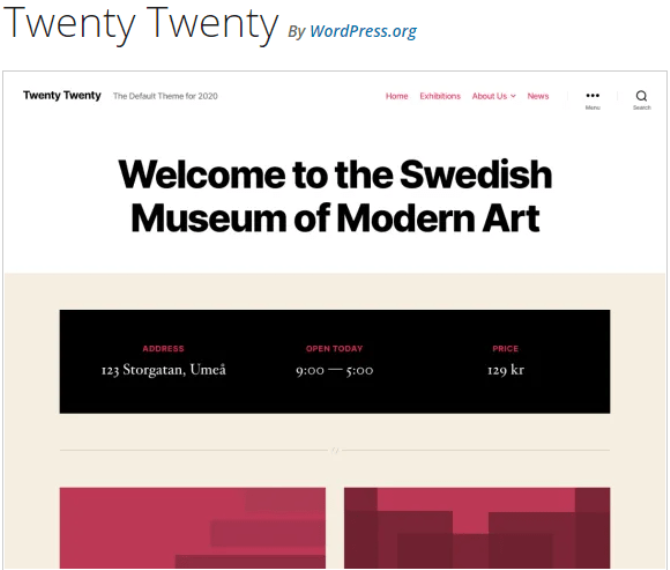
2020: Auto-updates for themes, plugins and major releases
Version 5.4 “Adderley” was released on March 31, supported by 552 contributors. Named after the Jazz trumpeter Nat Adderley, this version has a brand new welcome guide, improved blocks in editor including three new blocks, enhanced privacy tools and API improvements to better tab menu navigation for keyboard users. WordPress powers around 35% of the web in one form or another now.
Version 5.5 “Eckstine” named in honour of Billy Eckstine was released on August 11, 2020. It focused on three major areas – speed, search, and security. It finally brought to fruition the decade long demand of WP users – auto-updates for WordPress themes and plugins. The other features were updating themes and plugins via Zip file, improvements to block editor including new block patterns and block directory, default XML Sitemaps, a new esc_xml() function, lazy-loading images and more support for JavaScript i18n.
Version 5.6 “Simone” (named for the legendary performer Nina Simone) released on December 08, 2020 is a historical achievement with an all-women and non-binary release squad led by Josepha Haden. It introduced a new default theme, Twenty Twenty One, block editor improvements, auto-update option for major releases (finally!), increased support for PHP 8, application passwords for REST API authentication and better accessibility.

2021: Drag-and-drop for blocks and patterns
Version 5.7 “Esperanza” named in honour of Esperanza Spalding was released on March 09, 2021. The new editor is easier to use and you can do more without writing custom code. It has drag-and-drop for blocks and patterns, a streamlined admin colour palette, and one-click migration from HTTP to HTTPS. It also includes native support for lazy loading iframes, a follow-up to WordPress’ support for lazy loading for images that came in 5.5.
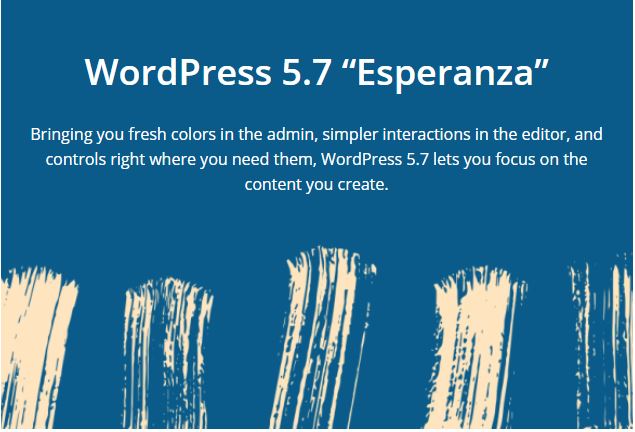
The second major release in 2021, WordPress 5.8 ‘Tatum’ is named in honour of Art Tatum, the legendary Jazz pianist. The WordPress 5.8 release was led by Matt Mullenweg and is the reflection of the hard work of 530 generous volunteer contributors. The release team closed over 320 Trac tickets and over 1,500 GitHub pull requests to make Tatum release possible. Full site editing, new Gutenberg blocks, WebP support, stopping Internet Explorer support etc are some of the exciting new features in this version.
2022: Full Site Editing and More
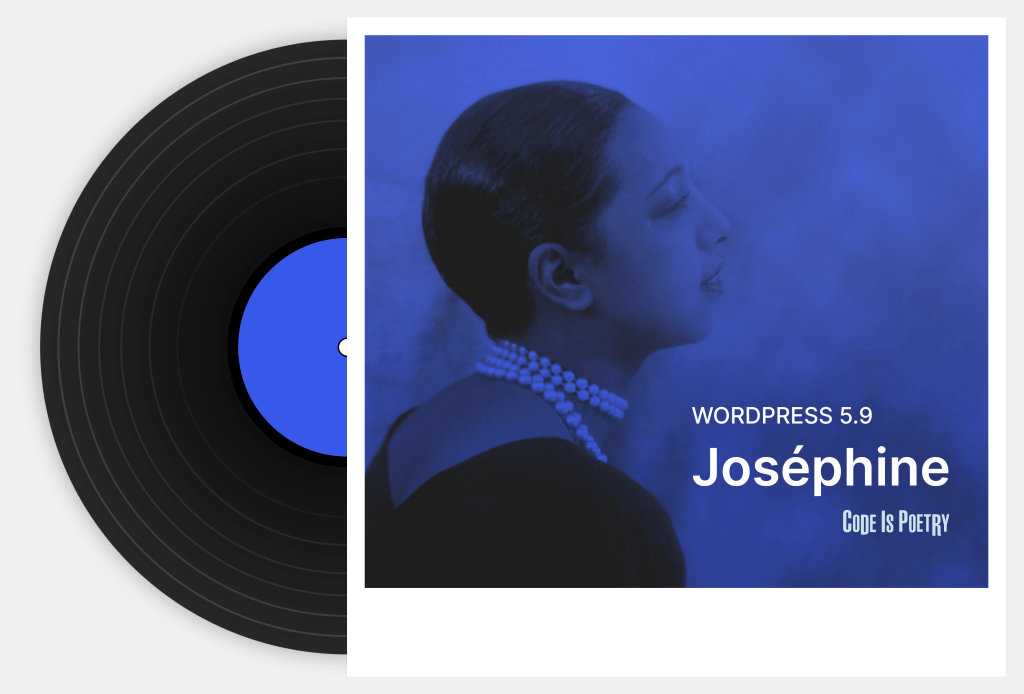
Version 5.9, “Joséphine”, named in honour of acclaimed international jazz singer Joséphine Baker, puts you in control of your whole site with full site editing. It also comes with Twenty-Twenty two, the default theme that is much more than just a theme. Block themes are its speciality, with a wide array of visual choices including colour schemes, font combinations, page templates and image filters. There is also a navigation block that gives you the ability to choose from a responsive menu to one that adapts to the screen size of the user. In general, version 5.9 is the best update so far, with extremely enticing features.
Version 6.0, “Arturo” named after the Grammy-winning jazz musician, Arturo O’Farnil is finally here. With lots of new features that take the customisation game and writing experience to a whole new level. The all-new global style switcher, improved export theme functionality, the much-awaited ability to select text across multiple blocks, additional design tools, block locking UI and many more features are now accessible to everyone. More template choices have also been introduced while focusing on improving the writing experiences with the help of quick insertion of internal links, styling elements retention, and more.
All these features and more set the perfect stage for the next step in the evolution of WordPress.
Version 6.1, “Misha” named in honor of Mikhail “Misha” Alperin, a Soviet-Norwegian jazz pianist who is celebrated as a founding member of the Moscow Art Trio comes with a lot of improvements to the full site editing. 6.1 has seen a drastic improvement in the number of contributors with over 800 contributors. It also comes with a new default theme, Twenty Twenty-Three with 10 style variations out of the box, a lot of new templates, improved performance, more design tools, improved block lock settings, fluid typography, header, and footer patterns, spacing presets, and more.
2023: End of Gutenberg Phase 2

Version 6.2: The first release of 2023, WordPress 6.2 “Dolphy” named after the American multi-jazz instrumentalist Eric Allan Dolphy Jr has arrived and marks the closure of Gutenberg Phase 2. Over 600 contributors have contributed to this release. The new features set includes a new Site Editor, improvements to the navigation block, Distraction Free mode, Openverse integration, the ability to copy and paste block styles, sticky positioning, and many more.
Exciting times are ahead as Gutenberg Phase 3 is in the pipeline for 2023.
Version 6.3, “ Lionel “ named in honor of Lionel Leo Hampton, an American jazz vibraphonist, pianist, percussionist, and bandleader, is the second major release of 2023. This release marks the end of Phase 2 of the Gutenberg Project, as well as the end of support for PHP 5 with the new minimum supported version of PHP being 7.0.0.
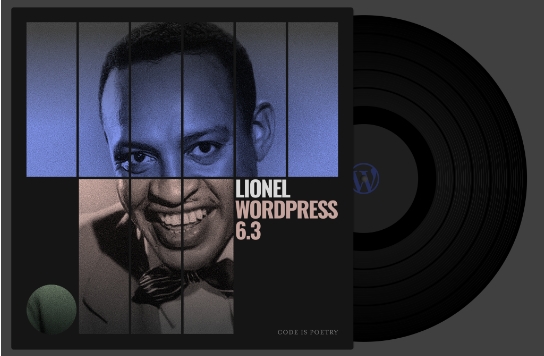
This version introduces a revamped site editor, reusable blocks being renamed to Patterns, a new details block and footnote block, a new Command Palette, performance improvements, and various other enhancements.
2024: Start of Gutenberg Phase 3

Version 6.5: “Regina” named in honor of Regina Carter an American jazz violinist marks the beginning of Phase 3 of the Gutenberg Project. Over 700 contributors have contributed to this release. This release comes with an all-new Font Library for easy managing of fonts, several new APIs, a change in the minimum version of MySQL, and more.
This is not the end of the story. WordPress continues to mesmerize the world and retain its charm. The noble quest for a leaner, cleaner and safer web still continues with Matt at the helm.
